Are you a captive of the engaging Macromedia Flashes? Do you want to play them on your computer or potable devices? If so, come with Moyea SWF to Video Converter,and you will find it easy and simple to access:
Moyea SWF to Video Converter Pro can convert local SWF to Video and convert online SWF to Video. Here in this tutorial, we take converting local swf to video in single and batch mode as the examples.
Step1: Download Moyea SWF to Video Converter Pro software on http://www.flash-video-mx.com/swf_to_video_pro/, install and launch it.
Step2: Input source SWF file. Moyea SWF to Video Converter Pro offers "Crop video" and "Capture" function, so this step contains three parts:
1. Input SWF File from local computer
Click "V" behind" Browse…" tab, a drop list will cascade automatically. There are four choices: From Folder, From IE cache, From URL and Flash Projector, we choose "From Folder" here, a dialog box accordingly will pop up, we choose the source file in the dialog box and click "OK". Also, we can click "Browse…" tab to input SWF file from local computer folder directly.
After inputting, the properties of input source file are on the right of pane.

Note: On opening the window, you will get "Single Mode" conversion, if you have many files to convert, it is recommended to choose "Switch to batch mode" on the top left.
2. Capture Pictures
Click "Original" in Background Color box, there will pop up a pigment pane, you can select one color or just DIY a color for your video background.
Click "Camera" tab to capture pictures of the playing flash, and captured image files will be saved as JPEG format files.
Click "folder" to check for its saving folder. You can click the button continuously for pictures, and check them together.
Click " Crop" to crop video.
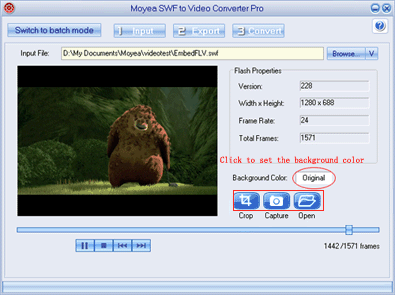
3. Crop Video
Click "Crop", the interface below will pop up.
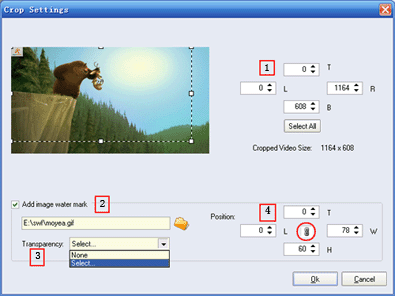
① Crop video. Crop the video size by changing the values on the right of pane. Choose "Select All", generated video will keep the original size. Or simply move your mouse cursor on the video pane to make it.
② Add image water mark. Check the "Add image water mark" box to add an image to video. Click "Folder" immediately behind to browse for image from your folder. Click "None" in the box to set the transparency of your image. "None" is for no editing, and on clicking "Select…" , there will be a dialog box pops up automatically.
③ Edit image. Set RGB values to DIY a color, showing in the bar below. Drag tolerance bar, you can easily get the picture altered in pixel; drag Alpha bar to adjust opacity of the picture. Click "OK" to continue. The interface are as follows:
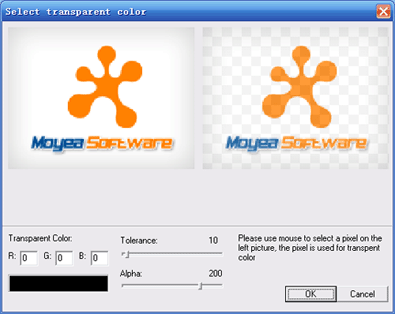
④ Set image position. Place the position of your image by changing values on the right side.
Click the lock in the core, then you can set one certain value without changing other values.
Step3: Output file settings. Click "Export" tab in menu, and you will get the following windows.
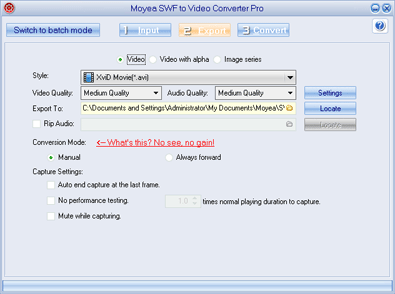
When choose to generate video with alpha channel
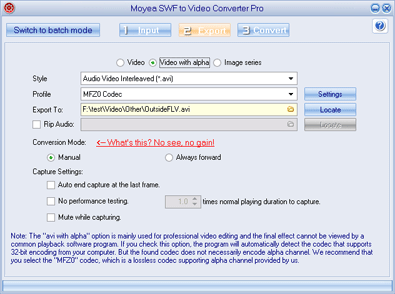
When choose to generate "Image series"
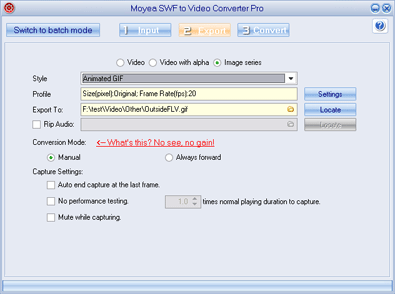
① Set the output file format: Select the output file's style and profile from the respective drop-down list, you can set the output file format. Moreover, you can click" Settings" to explore advanced profile settings, then the window below will pop up: (profile for the video)
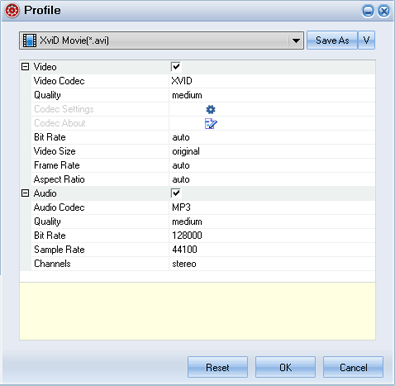
Profile settings for video with alpha channel
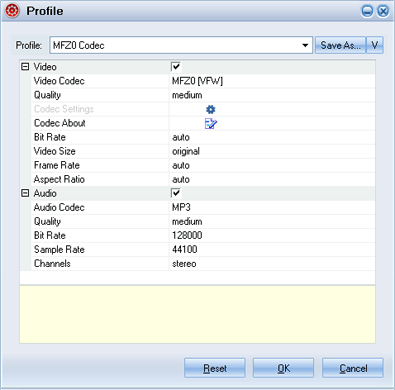
Profile for the image series:

Firstly, select the video style from the left frame, then select the profile from the drop-down list, click "Save as" immediately to save the profile you set as a new one. Click "V", you can save, rename, or delete the newly set. Change the video and audio parameters by clicking each item and selecting the value.
② Set the export destination folder: Click the folder in the "Export to" box to set the output destination, and click the "Locate" button, the destination folder will pop up immediately.
③ Rip the audio: Check the "Rip Audio" box, and the audio will be extracted and generated as a single file. Click the "folder" on the right to browse for the audio destination folder, and click the "Locate" button, the destination folder will pop up itself.
④ Select conversion mode: There are two conversion modes: Manual or Always forward. Select "Manual", you can interact in the conversion process by setting the capture start and end points. Click" What's this, No see, no gain!", a window will pop up giving you more information about manual conversion mode. Select "Always forward", you can't interact in the conversion process, and the program always captures forward the SWF file, it is helpful for Flash Game which interacts with people.
⑤ Capture settings: Check to" Auto end capture at the last frame", the program will stop capturing at the last frame automatically, this is available automatically when you have chosen "Always forward" conversion mode.
Check to "No performance testing", the" times normal playing duration to capture" for set the screen capturing speed is available. Set the speed, or just keep the default 1.0. If you change the default value, "Mute while capturing" will be available automatically.
Check to "Mute while capturing", it will be silent when capturing.
Step4: Conversion. Click "Convert" tab in menu, there will be an interface for your converting. On the interface, there will be several buttons: Option, Play and Capture, Play movie, Start Capture, Snapshot, Finish.
Option: Hit on option" button, there are two choices: Performance testing and Stopped frame.
① Click "Performance testing", interface below for you to set the working folder will pop up. Set the working folder or just keep the default. To guarantee an accurate result, you are suggested to interact with the flash when it asks you to. 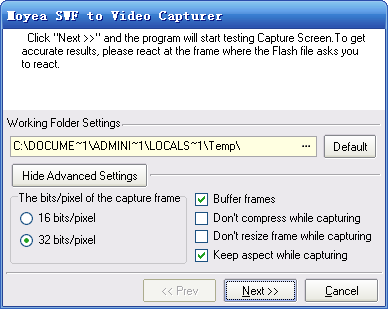
Click" Next>>", a bar showing the progress of performance testing appears. After the performance testing finished, the interface below for you to set the screen capturing speed pops up. Set the speed, or just keep the default. Check the "Mute while capture" box for silent capture. Click" OK" to finish the testing.

② Click " Stopped frame", the interface below will pop up. Check to" Stop at this frame" and set the frame, then program will stop capturing at this frame.

Play and Capture: Click this button, the SWF file will be played. Meanwhile, the program captures the file.
Play Movie: Click this button, the SWF file will be played while not being captured.
Start Capture: This button is available when there is SWF file being played. If you want to convert part of the SWF file, you can click this button when it comes to the specified part.
Snapshot: Click this button, you can capture the specific picture.
Finish: Click this button to stop your capturing. After finishing capture, the program starts encoding process.
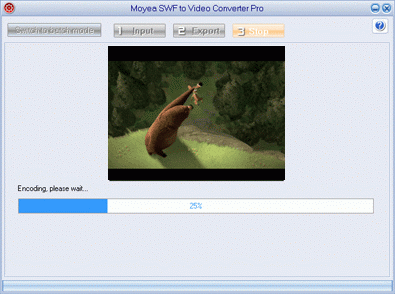
After a while, the conversion will complete. Confirm the "Conversion Completed" and the output folder will pop up automatically.
Well, the above instructions are for the single mode, and the converter can also convert files in batch mode in a much easier way, for it consists of only three steps!
On Opening the software, you will get this window for single mode conversion, click "Switch to batch mode" on the top left to shift to the batch mode conversion.
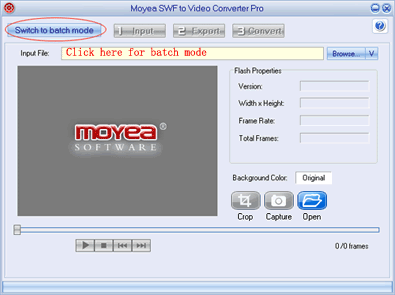
Step1: Input source SWF files
All are the same with the single mode files inputting, except that you can click each file name to play in the dialog box, and then select the check box before the items you want to convert. Of course , you can click "Check All" to select all, "Uncheck All" to delete all the selected. Choose "Invert" for the items selected. Then, click "OK" to confirm. Click each file name to play, during the playback, click the "Camera" to capture a picture, and the "Folder" to check the saving folder.
Click "Export" in the menu for the export settings.
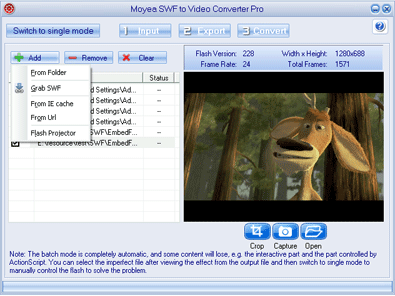
Note: ① As batch mode is default with the automatic conversion mode, some of the interactive or AScript controlled flashes with few frames may not be processed perfectly. It is recommended to shift this kind of files to "Single Mode" to convert under "Manual Mode" for a better result.
② In batch mode conversion, the water mark set will be added to all SWF files automatically.
Step2: Export Settings
All the same to the "Single Mode", except that you don't have to select conversion mode as well as capture settings, because batch mode is default with "always forward conversion", performance testing is played and the capture is silent by default, moreover, the program stop capture at the end frame by default too.
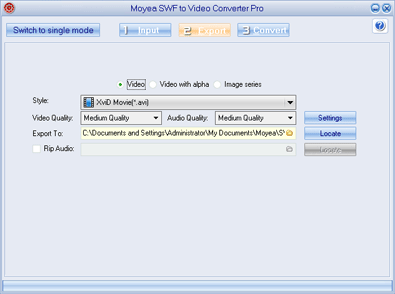
When choose to generate video with alpha
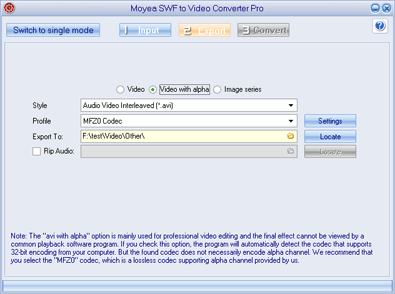
When choose to generate "Image series":
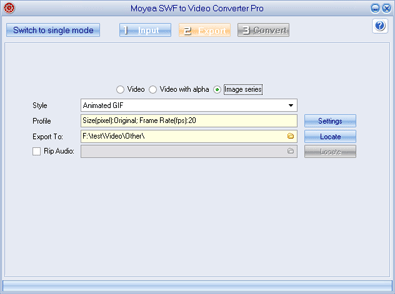
Then the program will move on to test the screen capturing speed, and encode one by one. Through this process, you can only set the end frame of each file by clicking the "Finish" button in the bottom toolbar.
Now, the conversion is completed. Confirm the "Conversion completed" and the output folder will pop up automatically. Now the rest is to enjoy your fancy!
TIPS: How to convert YouTube video(online SWF file) to video for prtable devices.